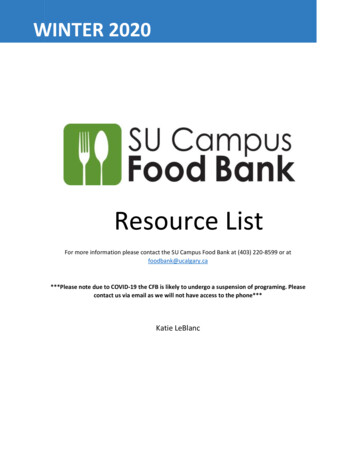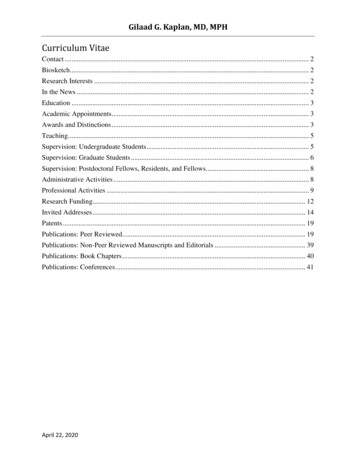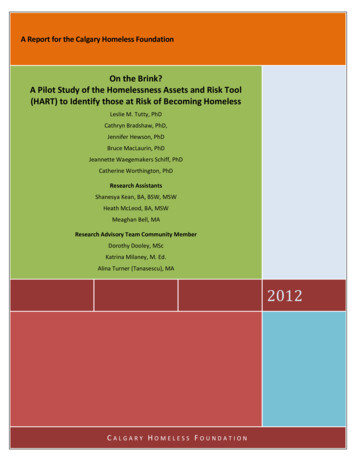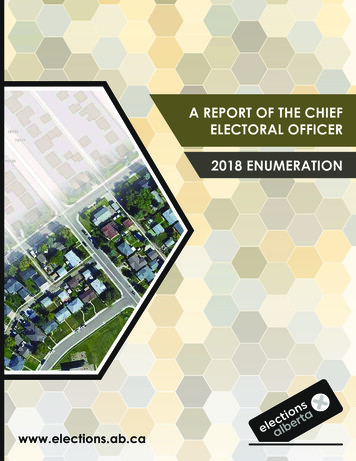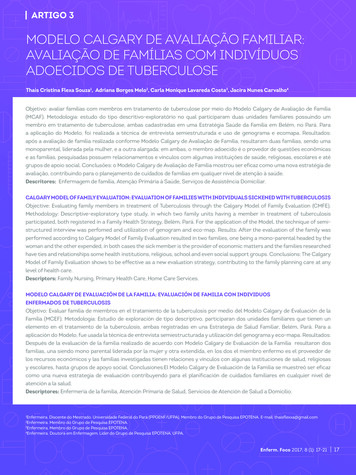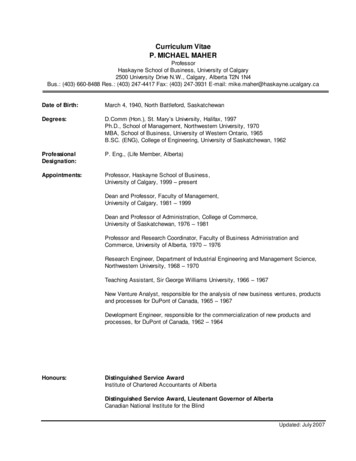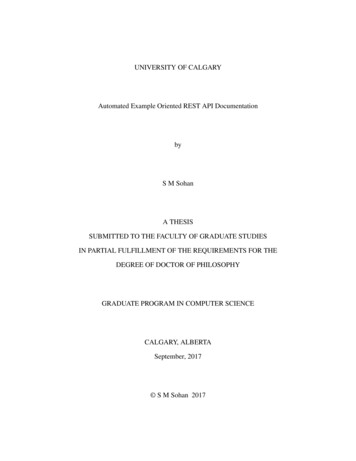
Transcription
UNIVERSITY OF CALGARYAutomated Example Oriented REST API DocumentationbyS M SohanA THESISSUBMITTED TO THE FACULTY OF GRADUATE STUDIESIN PARTIAL FULFILLMENT OF THE REQUIREMENTS FOR THEDEGREE OF DOCTOR OF PHILOSOPHYGRADUATE PROGRAM IN COMPUTER SCIENCECALGARY, ALBERTASeptember, 2017 S M Sohan 2017
UNIVERSITY OF CALGARYFACULTY OF GRADUATE STUDIESThe undersigned certify that they have read, and recommend to the Faculty of Graduate Studies foracceptance, a thesis entitled “Automated Example Oriented REST API Documenation” submittedby S M Sohan in partial fulfillment of the requirements for the degree of DOCTOR OF PHILOSOPHY.
Dr. Frank MaurerSupervisorDepartment of Computer ScienceUniversity of Calgary, CanadaDr. Mea WangSupervisory Committee MemberDepartment of Computer ScienceUniversity of Calgary, CanadaDr. Craig AnslowSupervisory Committee MemberSchool of Engineering andComputer ScienceVictoria University ofWellington, New ZealandDr. Nils Daniel ForkertInternal ExaminerDepartment of Radiology andHotchkiss Brain InstituteUniversity of Calgary, CanadaDr. Yves LucetExternal ExaminerComputer ScienceUniversity of British Columbia(Okanagan), CanadaDateiii
AbstractAPI documentation presents both a problem and an opportunity for API usability. REST APIsprovide interconnectivity between applications over HTTP. Documentation of a REST API is a keyinformation source for API client developers. Most REST APIs are documented using a manualapproach, which can be time consuming and error-prone. REST API developers need to efficientlydocument their APIs with qualities that make the API usable. In this research, I focused on thetopic of automated REST API documentation to satisfy this need.In this thesis, I present and evaluate of a novel technique to solve REST API documentationrequirements. I present a set of REST API documentation requirements by studying the existingliterature and the current industry practice. From this study, I observed that REST APIs evolvefrequently, but used a manual or bespoke approach for generating and maintaining their documentation. I present, SpyREST, a reusable technique with a prototype implementation to automate theREST API documentation process with executable API usage examples. The technique involvesthe interception of example REST API calls using an HTTP proxy server to auto-generate an accurate and updated REST API documentation. I present an industrial evaluation of the proposedtechnique based on a period of eighteen months of production use. From this study, I found thatit was feasible to leverage API test code to automatically generate an always-updated REST APIdocumentation for evolving REST APIs with usage examples. To evaluate the impact of usageexamples on REST API client developers, I performed a controlled study with experienced RESTAPI developers. From this case study, I found that REST API client developers faced patternsof obstacles using REST APIs that can be reduced by including API usage examples in the APIdocumentation, as suggested in the proposed technique.The findings of this research can be used as a guideline by practitioners to automatically generate REST API documentation with usage examples. Researchers can extend the novel conceptof using interception to automatically document API usage examples for other forms of APIs.iv
AcknowledgementsI am grateful to Shahana, my wife, for supporting me and the family while I took an unacceptableamount of the time and attention away from them to work on this research.I am thankful to my supervisor Dr. Frank Maurer for giving me the opportunity and valuableguidance to pursue this research. I am also thankful to Dr. Craig Anslow for his continuousencouragement and the countless number of hours that he spent to provide feedback about mywork.I am grateful to Cisco for allowing me to pursue this research alongside my job. I am gratefulto the study participants in my case studies for sharing their time with me on the experiments.v
DedicationTo my dear wife.vi
ContentsAbstract . . . . . . . . . . . . . . . . . . . . . . . . . . . . . . . . . . . . . . . . . .Acknowledgements . . . . . . . . . . . . . . . . . . . . . . . . . . . . . . . . . . .Dedication . . . . . . . . . . . . . . . . . . . . . . . . . . . . . . . . . . . . . . . .Contents . . . . . . . . . . . . . . . . . . . . . . . . . . . . . . . . . . . . . . . . . .List of Tables . . . . . . . . . . . . . . . . . . . . . . . . . . . . . . . . . . . . . . .List of Figures . . . . . . . . . . . . . . . . . . . . . . . . . . . . . . . . . . . . . . .List of Symbols . . . . . . . . . . . . . . . . . . . . . . . . . . . . . . . . . . . . . .1Introduction . . . . . . . . . . . . . . . . . . . . . . . . . . . . . . . . . . . . .1.1 Research Goals . . . . . . . . . . . . . . . . . . . . . . . . . . . . . . . . . . .1.2 Research Objectives . . . . . . . . . . . . . . . . . . . . . . . . . . . . . . . . .1.3 Cohesion and Unitary Report . . . . . . . . . . . . . . . . . . . . . . . . . . . .1.4 Contributions . . . . . . . . . . . . . . . . . . . . . . . . . . . . . . . . . . . .1.5 References . . . . . . . . . . . . . . . . . . . . . . . . . . . . . . . . . . . . . .2A Case Study of Web API Evolution . . . . . . . . . . . . . . . . . . . . . . . .2.1 Abstract . . . . . . . . . . . . . . . . . . . . . . . . . . . . . . . . . . . . . . .2.2 Introduction . . . . . . . . . . . . . . . . . . . . . . . . . . . . . . . . . . . . .2.3 Related Work . . . . . . . . . . . . . . . . . . . . . . . . . . . . . . . . . . . .2.3.1 Empirical Research on Web API Evolution . . . . . . . . . . . . . . . .2.3.2 Techniques to Evolve Web APIs . . . . . . . . . . . . . . . . . . . . . .2.3.3 Tool Support for Evolving Web APIs . . . . . . . . . . . . . . . . . . .2.4 Case Study . . . . . . . . . . . . . . . . . . . . . . . . . . . . . . . . . . . . .2.4.1 Research Questions . . . . . . . . . . . . . . . . . . . . . . . . . . . . .2.4.2 Selection Strategy . . . . . . . . . . . . . . . . . . . . . . . . . . . . .2.4.3 Research Method - Qualitative Analysis . . . . . . . . . . . . . . . . . .2.5 Findings . . . . . . . . . . . . . . . . . . . . . . . . . . . . . . . . . . . . . . .2.5.1 RQ1 Versioning . . . . . . . . . . . . . . . . . . . . . . . . . . . . . . .2.5.2 RQ2 Documentation . . . . . . . . . . . . . . . . . . . . . . . . . . . .2.5.3 RQ3 Communication . . . . . . . . . . . . . . . . . . . . . . . . . . . .2.6 Discussion . . . . . . . . . . . . . . . . . . . . . . . . . . . . . . . . . . . . . .2.7 Conclusion . . . . . . . . . . . . . . . . . . . . . . . . . . . . . . . . . . . . .2.8 References . . . . . . . . . . . . . . . . . . . . . . . . . . . . . . . . . . . . . .3SpyREST: Automated RESTful API Documentation using an HTTP Proxy Server3.1 Abstract . . . . . . . . . . . . . . . . . . . . . . . . . . . . . . . . . . . . . . .3.2 Introduction . . . . . . . . . . . . . . . . . . . . . . . . . . . . . . . . . . . . .3.3 Related Work . . . . . . . . . . . . . . . . . . . . . . . . . . . . . . . . . . . .3.3.1 General API Documentation . . . . . . . . . . . . . . . . . . . . . . . .3.3.2 RESTful API Documentation . . . . . . . . . . . . . . . . . . . . . . .3.4 SpyREST . . . . . . . . . . . . . . . . . . . . . . . . . . . . . . . . . . . . . .3.4.1 Requirements . . . . . . . . . . . . . . . . . . . . . . . . . . . . . . . .3.4.2 Design . . . . . . . . . . . . . . . . . . . . . . . . . . . . . . . . . . .3.4.3 Features . . . . . . . . . . . . . . . . . . . . . . . . . . . . . . . . . . .3.5 SpyREST Case Study . . . . . . . . . . . . . . . . . . . . . . . . . . . . . . . 229303134353838384040414242434648
5.65.75.85.963.5.1 SpyREST Documentation vs. Official Documentation . . . . . . . . .Discussion . . . . . . . . . . . . . . . . . . . . . . . . . . . . . . . . . . . . .3.6.1 Threats to Validity . . . . . . . . . . . . . . . . . . . . . . . . . . . .Conclusion . . . . . . . . . . . . . . . . . . . . . . . . . . . . . . . . . . . .References . . . . . . . . . . . . . . . . . . . . . . . . . . . . . . . . . . . . .SpyREST in Action: An Automated RESTful API Documentation Tool . . . .Abstract . . . . . . . . . . . . . . . . . . . . . . . . . . . . . . . . . . . . . .Introduction . . . . . . . . . . . . . . . . . . . . . . . . . . . . . . . . . . . .SpyREST . . . . . . . . . . . . . . . . . . . . . . . . . . . . . . . . . . . . .4.3.1 Design . . . . . . . . . . . . . . . . . . . . . . . . . . . . . . . . . .4.3.2 Implementation . . . . . . . . . . . . . . . . . . . . . . . . . . . . . .Use Cases . . . . . . . . . . . . . . . . . . . . . . . . . . . . . . . . . . . . .4.4.1 Initial API Documentation . . . . . . . . . . . . . . . . . . . . . . . .4.4.2 Maintaining API Documentation for Evolving APIs . . . . . . . . . . .Discussion . . . . . . . . . . . . . . . . . . . . . . . . . . . . . . . . . . . . .Related Work . . . . . . . . . . . . . . . . . . . . . . . . . . . . . . . . . . .Conclusion . . . . . . . . . . . . . . . . . . . . . . . . . . . . . . . . . . . .References . . . . . . . . . . . . . . . . . . . . . . . . . . . . . . . . . . . . .Automated Example Oriented REST API Documentation at Cisco . . . . . . .Abstract . . . . . . . . . . . . . . . . . . . . . . . . . . . . . . . . . . . . . .Introduction . . . . . . . . . . . . . . . . . . . . . . . . . . . . . . . . . . . .Related Work . . . . . . . . . . . . . . . . . . . . . . . . . . . . . . . . . . .5.3.1 API Usability and Documentation . . . . . . . . . . . . . . . . . . . .5.3.2 Usage Examples in API Documentation . . . . . . . . . . . . . . . . .5.3.3 REST API Documentation . . . . . . . . . . . . . . . . . . . . . . . .REST API Documentation Tool Selection . . . . . . . . . . . . . . . . . . . .5.4.1 Requirements . . . . . . . . . . . . . . . . . . . . . . . . . . . . . . .5.4.2 Evaluation of Tools . . . . . . . . . . . . . . . . . . . . . . . . . . . .SpyREST – Overview . . . . . . . . . . . . . . . . . . . . . . . . . . . . . . .Case Study: SpyREST at Cisco . . . . . . . . . . . . . . . . . . . . . . . . . .5.6.1 Methodology . . . . . . . . . . . . . . . . . . . . . . . . . . . . . . .5.6.2 Context . . . . . . . . . . . . . . . . . . . . . . . . . . . . . . . . . .5.6.3 The API Development Process . . . . . . . . . . . . . . . . . . . . . .Discussion . . . . . . . . . . . . . . . . . . . . . . . . . . . . . . . . . . . . .5.7.1 REST API Documentation from Test Code . . . . . . . . . . . . . . .5.7.2 Maintaining Custom Content . . . . . . . . . . . . . . . . . . . . . . .5.7.3 Handling Flexible API Elements . . . . . . . . . . . . . . . . . . . . .5.7.4 API Documentation Life-cycle . . . . . . . . . . . . . . . . . . . . . .5.7.5 API Changelog . . . . . . . . . . . . . . . . . . . . . . . . . . . . . .5.7.6 Cross-Referencing API Elements . . . . . . . . . . . . . . . . . . . .5.7.7 Extending beyond REST API Documentation . . . . . . . . . . . . . .5.7.8 Limitations . . . . . . . . . . . . . . . . . . . . . . . . . . . . . . . .Conclusion . . . . . . . . . . . . . . . . . . . . . . . . . . . . . . . . . . . .References . . . . . . . . . . . . . . . . . . . . . . . . . . . . . . . . . . . . .A Study of the Effectiveness of Usage Examples in REST API 959696101
6.16.26.36.46.56.66.76.86.977.1ABAbstract . . . . . . . . . . . . . . . . . . . . . . . . . .Introduction . . . . . . . . . . . . . . . . . . . . . . . .Research Question . . . . . . . . . . . . . . . . . . . .Methodology . . . . . . . . . . . . . . . . . . . . . . .6.4.1 Study API . . . . . . . . . . . . . . . . . . . . .6.4.2 Study Design . . . . . . . . . . . . . . . . . . .Results . . . . . . . . . . . . . . . . . . . . . . . . . . .6.5.1 Quantitative Analysis . . . . . . . . . . . . . . .6.5.2 Qualitative Analysis Results . . . . . . . . . . .Threats to Validity . . . . . . . . . . . . . . . . . . . . .Related Work . . . . . . . . . . . . . . . . . . . . . . .Conclusion . . . . . . . . . . . . . . . . . . . . . . . .References . . . . . . . . . . . . . . . . . . . . . . . . .Conclusion . . . . . . . . . . . . . . . . . . . . . . . .Future Work . . . . . . . . . . . . . . . . . . . . . . . .Source Code Fragments of the Spy from Chapter 4 . . .Permissions for Reusing Published Papers in PhD 6129131146
List of Tables1.1Summary and Flow of Arguments of the Sub-projects . . . . . . . . . . . . . . . .2.12.2Case Study - Representative Sample of Web APIs. . . . . . . . . . . . . . . . . . . 19List of Codes . . . . . . . . . . . . . . . . . . . . . . . . . . . . . . . . . . . . . 214.1Examples of Auto Detected Versions . . . . . . . . . . . . . . . . . . . . . . . . . 595.15.2REST API Documentation . . . . . . . . . . . . . . . . . . . . . . . . . . . . . . 77Comparison of Tools against the Requirements . . . . . . . . . . . . . . . . . . . 796.1Participant Profile . . . . . . . . . . . . . . . . . . . . . . . . . . . . . . . . . . . 111x7
List of Figures1.1Manual REST API Documentation Steps . . . . . . . . . . . . . . . . . . . . . . .2.1Case Study - Change Profiles for the Web APIs. . . . . . . . . . . . . . . . . . . . 273.1SpyREST Screenshots Showing Auto Generated API Documentation . . . . . . . . 454.14.2SpyREST Design . . . . . . . . . . . . . . . . . . . . . . . . . . . . . . . . . . . 57SpyREST Screenshots Showing Auto Generated API Documentation . . . . . . . . 605.15.2Screenshots of the REST API Documentation from Cisco using SpyREST . . . . . 83API Development workflow using SpyREST at Cisco . . . . . . . . . . . . . . . . 866.16.2Screenshot of Documentation for Post/date . . . . . . . . . . . . . . . . . . . .Screenshot of the Custom-built Web-based REST API Explorer Used by StudyParticipants . . . . . . . . . . . . . . . . . . . . . . . . . . . . . . . . . . . . .Screenshots of Original vs. Enhanced API Documentation . . . . . . . . . . . .Quantitative Comparison between G1 and G2 . . . . . . . . . . . . . . . . . . .Participation Satisfaction Ratings on a Scale of 0-10 . . . . . . . . . . . . . . . .6.36.46.5xi3. 106.109110115116
List of Symbols, Abbreviations and NomenclatureSymbolDefinitionAPIApplication Programming InterfaceHTTPHyper Text Transfer ProtocolJSONJavaScript Object NotationRESTRepresentational State Transfer, used interchangeably with RESTfulSOAPSimple Object Access ProtocolWSDLWeb Service Definition LanguageXMLExtensible Markup Languagexii
Chapter 1IntroductionRobillard defines an API as follows: An API is the interface to implement functionality that developers can access to perform various tasks [1, 2]. Application Programming Interfaces, commonlyknown as APIs, are used to express a software component in terms of its operations, inputs, outputs,and their types1 . APIs enable multiple software components to interact with each other. Web APIsallow software-to-software interconnectivity using web technologies as the transport mechanismbetween systems.REST APIs are a type of API that are used to integrate software components using web technologies. Fielding defined Representational State Transfer or REST as an architectural style fordeveloping distributed hypermedia systems [3]. He described the design of modern Web as anexample of a REST-style architecture. REST-style architecture allows software components tosatisfy the data transfer needs of the modern Internet-scale applications by leveraging a generic interface based on URIs and Internet media types that allow intemediate processing such as cachingto improve system performance.REST APIs allow access to application resources over HTTP. While REST describes a genericprotocol for accessing application resources, the applications are responsible for the specific representation of the resources. For example, a REST API may support multiple Internet media typessuch as JSON, XML, CSV for a single application resource. Similarly, two different REST APIsmay use the same media type but contain entirely different formats to represent their objects.For example, GitHub, an online code repository hosting tool, has a REST API that can beused by third-party applications to integrate with GitHub features. The GitHub REST API2 hasa resource called Repository to denote a code repository that can be identified by the URL1 https://en.wikipedia.org/wiki/Application programming interface2 https://developer.github.com/v3/repos/#create1
/user/repos. To create a new Repository for a user, the GitHub API can be invoked viaHTTP POST at /user/repos using the following JSON representation of a Repository:{"name": "Hello-World","description": "This is your first repository","homepage": "https://github.com","private": false,"has issues": true,"has wiki": true,"has downloads": true}In today’s world of technology, REST APIs have become ubiquitous and the primary choicefor integrating Internet enabled applications due to its simplicity and similarity with HTTP [4]. Forexample, a real estate listing website uses a REST API to collect “walk score” and another RESTAPI to show a map view of a property listing. By incorporating the map and walk score using RESTAPIs, the real estate listing site provides important information to their users. Most REST APIs,including these two examples, are often documented manually or using custom implemented toolsspecific to the APIs that are not publicly available. This requires effort to generate and maintainthe documentation of REST APIs over time since there is a lack of reusable tool support.Previous research in the area of API usability mostly focused on local APIs such as Java libraries. Researchers identified the documentation of APIs as both the primary source of information as well as the key obstacle for API usability [2]. Hence the quality of the API documentationplays an important role in API usability. To this regard, researchers have identified the qualities of“good API documentation” as follows: complete, correct, includes thorough explanations and codeexamples, provides consistent presentation and organization [2, 5]. Today, there are several tools2
such as Javadoc3 , UsETeC [6], Jadeite [7], APIMiner [8], Roast [9] that can be used to documentlocal APIs with the aforementioned qualities .While there are overlaps between the documentation requirements of local and REST APIs,there are significant requirements that are unique to each. The documentation of most local APIscontain a structural definition of the API classes and methods. API usage examples for local APIsare documented using the same programming language of the API. On the other hand, RESTAPIs are defined using HTTP specific parameters such as API endpoints, query parameters, HTTPheaders and body. REST API clients can be written in any programming language agnostic tothe API implementation language. Due to such structural and implementation differences betweenlocal and REST APIs, the existing technique and tools for local API documentation cannot bereadily used to generate REST API documentation.Figure 1.1: Manual REST API Documentation StepsCurrently, the process of documenting REST APIs is largely manual. Conceptually, the highlevel steps involved in the manual process can be identified as shown in Figure 1.1. These stepsS1-S7 can be described as follows: S1 - API developer prepares an example API with the required HTTP parametersand request body. S2 - API developer uses a REST API client to make the example API call. S3 - the API developer records the HTTP data.3 mentation/index-jsp-135444.html3
S4 - API developer then edits the recorded data so that only relevant content isselected for documentation. S5 - API developers use any custom content to describe the API example. S6 - API developers combine the custom content with the edited content from theHTTP traffic into HTML to publish on the web. S7 - API developer adds custom overview information to explain API concepts andgeneral rules, and publishes the final documentation so other developers can learnthe API.The steps S1-S6 are repeated for every API action that needs to be documented, and S1-S7need to repeated for every version of the REST API as it evolves. As depicted here, this manualprocess can be both time consuming and error-prone.1.1Research GoalsThe overarching goal of my research is to improve the current state of the process of REST APIdocumentation process by automating the repeating manual steps in the aforementioned workflow.More specifically, I aimed to solve the following research goals: RG1: To identify a set of REST API documentation requirements. Existing researchon API usability has derived a number of API documentation requirements primarily focusing on local APIs. Due to the structural and implementation differencesbetween local and REST APIs, I aimed to identity REST API specific documentation requirements in my research. This has several implications as follows: havingaccess to a scientifically derived list of REST API documentation requirements allows REST API developers to make an informed decision related to planning andexecution of their documentation efforts. The requirements provide a background4
research that can be used by practitioners to compare and contrast existing RESTAPI documentation tools while selecting an appropriate tool for their API. RESTAPI documentation tool developers can also use the requirements to build necessaryfeatures. RG2: To develop and evaluate a technique to overcome the commonly observedchallenges related to REST API documentation. I aimed to devise a reusable technique so that REST APIs can be documented following the identified REST APIdocumentation requirements without following manual or bespoke methods. It hasthe following implications: REST API developers can utilize the technique to overcome the common challenges with the generation and maintenance of their APIdocumentation, and REST API client developers can access an API documentation.1.2Research ObjectivesRelated to RG1 and RG2, I aimed to address the following research questions as my objectives: RO1: How are evolving REST APIs documented? This question is aimed to analyze the gap between current industry practice around the documentation of evolving REST APIs and the proposed solutions from existing literature. This objectivehelped me to identify the research opportunity to work on unresolved problemsrelated to REST API documentation. RO2: What are the requirements for usable REST API documentation? This objective provides a necessary background for improving the state of REST API documentation process. RO3: What technique can be used to document REST APIs to meet the requirements? This is the central research objective. I researched to develop a new tech-5
nique that can fill the gap between existing REST API documentation methods andthe identified requirements. RO4: Is the proposed technique a practical one for REST API developers? A qualitative evaluation of the proposed technique in a real-world setup is needed to understand the feasibility and the shortcomings of the proposed technique from theperspective of the REST API developers. RO5: How does a documentation using the proposed technique impact REST APIclient developers? This question investigates the impact of the proposed techniquefrom the perspective of the REST API client developer effort and success rate whileperforming API tasks.1.3Cohesion and Unitary ReportTo address the aforementioned research goals and objectives, my research strategy included fivesub-projects, have resulted in publications at peer-reviewed international conferences. Table 1.1shows a high level overview of the flow of arguments between the sub-projects to meet the researchgoals.The first research project is described in Chapter 2, where I discuss a case study to summarizethe state of existing literature and industry practices related to the versioning, documentation, andchange communication patterns of evolving Web APIs [10]. The results are based on a study ofnine industrial APIs. I found a lack of reusable techniques in the existing literature to automaticallygenerate and maintain the documentation of multi-version evolving REST APIs with usage examples. I pursued further research to solve this problem as discussed in the following paragraphs.In Chapter 3, I discuss my second research project where I derived a set of REST API documentation requirements and proposed a new technique to meet the requirements [11]. Here, Ipresent a list of REST API documentation requirements by studying the literature and applying the6
Table 1.1: Summary and Flow of Arguments of the Sub-projectsChapterGoalChapter 2 RG1Objective Research ProjectPrimary OutcomeRO1A case study of Web APIA set of challenging problems re-evolution [10].lated to evolving Web APIs. Selected REST API documentation asthe problem of interest for this research.Chapter 3 RG1 andRG2Chapter 4 RG2RO2 andSpyREST:RO3RESTful API documenta-ceptual design using interception totion using an HTTP proxygenerate REST API documentationserver [11].to meet the requirements.SpyREST in action: AnA reusable tool that implements theautomated RESTful APIconceptual design and shows howdocumentation tool [12].the identified REST API documen-RO3AutomatedA list of requirements.A con-tation requirements are met.Chapter 5 RG2RO4Automated example ori-Empirical evidence that the pro-ented REST API docu-posed technique provides a prac-mentation at Cisco [13].tical documentation solution forREST API developers.Chapter 6 RG2RO5A study of the effective-Empirical evidence that the pro-ness of usage examples inposed technique allows REST APIREST API documentationclient developers to perform API[14].tasks with less effort, higher success and satisfaction ratings.7
findings from Chapter 2. I discuss the available REST API documentation techniques and compareagainst the requirements. I present, SpyREST, a novel technique to intercept example REST APIcalls using an HTTP proxy server to collect and automatically synthesize API traffic to generateand update API documentation to satisfy the identified requirements. The primary advantage ofthe presented technique is that the documentation is generated from executable code. As a result, acontinuously updated REST API documentation with realistic usage examples is achievable with areduced manual effort. The remaining chapters provide evidence that the proposed technique cansatisfy the identified requirements.I present my third research project, related to RG2, in Chapter 4, where I present a prototypeimplementation of the aforementioned technique [12]. In this prototype implementation, I discussthe process that transforms a number of example HTTP requests and responses into usable RESTAPI documentation. I also present an example where automated test code is used to generate andmaintain a continuously updated REST API documentation using the developed tool.I discuss my fourth research project, related to RG2, involving an industrial evaluation of theproposed technique and the tool in Chapter 5 [13]. The evaluation is carried out based on thedata collected from an eighteen month of production use of SpyREST at Cisco, my current employer. From the study I found that it is feasible to use the proposed interception technique andautomated tests to document evolving REST APIs satisfying the previously presented REST APIdocumentation requirements. Automated always-updated REST API documentation was found tohelp establish a quick feedback cycle among the stakeholders. I also discuss several refinementsand limitations of the proposed technique based on the lessons learned from this case study.I present my fifth research project, related to RG2, in Chapter 6, where I discuss a controlledstudy to understand the impact of usage examples in API documentation on REST API client developers [14]. I observed that providing usage examples with data taken from API test code reducesthe obstacles and improves API client developer success rate, reduces required trial attempts, andimproves satisfaction ratings. The findings from this study provides an empirical evidence that by8
using the proposed technique of generating REST API documentation from API test code can helpAPI client developers to achieve a higher level of success with a reduced effort.In Chapter 7, I conclude by discussing how the research objectives are achieved and provide alist of problems for future research.1.4ContributionsIn summary, this thesis makes the following key contributions to the body of research in softwareengineering:1. A list of REST API documentation requirements derived from the existing literatureand the current state of industry practices to be used as a guideline by practitionersand researchers.2. SpyREST, a novel technique and a reusable tool that uses interception to automatically generate and maintain evolving REST API documentation with usage examples from executable code.3. An industrial evaluation of SpyREST to demonstrate the feasibility of the proposedtechnique that REST API developers can follow to improve their REST API documentation experience.4. An empirical evidence showing the common obstacles faced by REST API clientdevelopers that can be reduced with usage examples to help the prioritization ofREST API documentation efforts.1.5References
topic of automated REST API documentation to satisfy this need. In this thesis, I present and evaluate of a novel technique to solve REST API documentation requirements. I present a set of REST API documentation requirements by studying the existing literature and the current industry practice. From this study, I observed that REST APIs evolve

